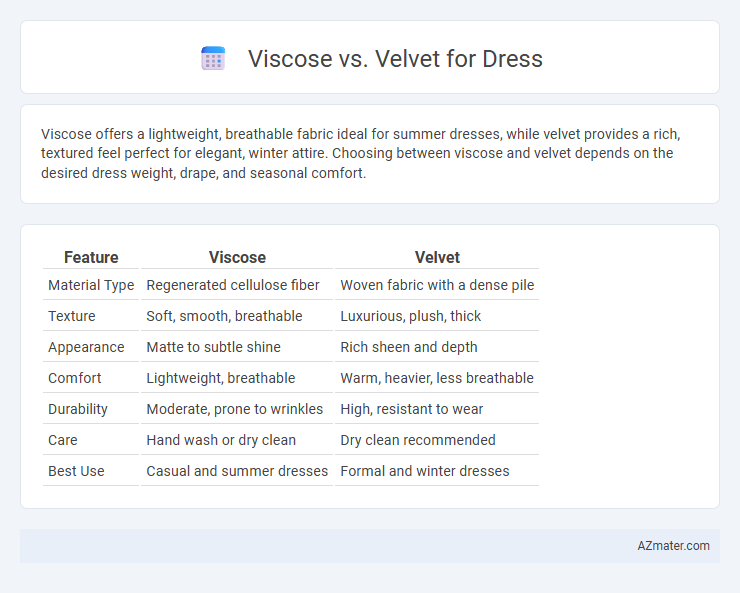Viscose offers a lightweight, breathable fabric ideal for summer dresses, while velvet provides a rich, textured feel perfect for elegant, winter attire. Choosing between viscose and velvet depends on the desired dress weight, drape, and seasonal comfort.
Table of Comparison
| Feature | Viscose | Velvet |
|---|---|---|
| Material Type | Regenerated cellulose fiber | Woven fabric with a dense pile |
| Texture | Soft, smooth, breathable | Luxurious, plush, thick |
| Appearance | Matte to subtle shine | Rich sheen and depth |
| Comfort | Lightweight, breathable | Warm, heavier, less breathable |
| Durability | Moderate, prone to wrinkles | High, resistant to wear |
| Care | Hand wash or dry clean | Dry clean recommended |
| Best Use | Casual and summer dresses | Formal and winter dresses |
Understanding Viscose: Fabric Overview
Viscose is a semi-synthetic fabric made from regenerated cellulose fibers derived from wood pulp, offering a soft and breathable texture ideal for dresses. It drapes well and provides a smooth, silky feel, making it comfortable and stylish for various dress designs. Unlike velvet, viscose is lighter and more moisture-absorbent, enhancing wearability in warmer climates while maintaining a luxurious appearance.
What is Velvet? Key Characteristics
Velvet is a luxurious textile known for its dense pile weave, giving it a soft and plush texture that reflects light to create a rich, elegant sheen. Typically made from silk, cotton, or synthetic fibers, velvet features a distinctive cut pile that makes it thicker and more insulating than viscose. Its durability, weight, and smooth surface make velvet ideal for formal dresses and evening wear, offering a sophisticated look that contrasts with the lighter, more breathable qualities of viscose.
Texture and Feel: Viscose vs Velvet
Viscose offers a smooth, breathable texture with a soft, lightweight feel ideal for dresses that require fluid draping and comfort. Velvet, characterized by its dense, plush pile, provides a rich, luxurious texture with a heavier, warmer feel, making it perfect for elegant, structured dresses. The choice between viscose and velvet depends on the desired tactile experience and dress style, balancing softness and breathability against opulence and warmth.
Breathability and Comfort Compared
Viscose offers superior breathability compared to velvet, making it an ideal choice for warm weather or extended wear due to its moisture-wicking properties and lightweight texture. Velvet, while luxurious and soft with a plush pile, tends to retain heat and lacks the same level of air circulation, potentially causing discomfort in hot conditions. For dresses prioritizing comfort and airflow, viscose provides a cooler, more breathable fabric option than the dense, heavier velvet.
Appearance and Draping Qualities
Viscose offers a smooth, silky appearance with excellent draping qualities that create fluid, flowing silhouettes ideal for elegant dresses. Velvet features a rich, plush texture with a lustrous, opulent sheen, providing a structured drape that adds volume and depth to garment designs. Both fabrics contribute distinct visual and tactile effects, with viscose excelling in softness and movement, while velvet emphasizes luxury and dimensionality.
Durability and Maintenance Needs
Viscose and velvet differ significantly in durability and maintenance requirements for dresses. Viscose, a semi-synthetic fiber made from cellulose, offers moderate durability but tends to weaken when wet and is prone to shrinking, requiring gentle hand washing or dry cleaning. Velvet, often made from silk or synthetic fibers, is more resilient and resistant to wear, but demands careful maintenance such as professional cleaning and avoiding excessive friction to preserve its plush texture and sheen.
Cost Comparison: Viscose vs Velvet
Viscose dresses typically cost less than velvet dresses due to the lower price of viscose fibers and simpler manufacturing processes. Velvet, made from materials like silk or polyester with a dense pile weave, involves higher production costs resulting in a more expensive garment. Budget-conscious shoppers often prefer viscose for its affordability, while velvet is chosen for its luxurious texture despite the higher price.
Best Occasions for Each Fabric
Viscose dresses are ideal for daytime events and casual gatherings due to their lightweight, breathable nature and smooth drape, making them comfortable in warm weather. Velvet dresses, with their rich texture and luxurious sheen, are perfect for evening occasions, formal events, and winter parties, offering a sophisticated and elegant appearance. Choosing between viscose and velvet depends on the event's dress code and season, as viscose suits relaxed and warm settings while velvet excels in upscale, cooler environments.
Sustainability and Eco-Friendliness
Viscose is a semi-synthetic fiber derived from cellulose, often produced through energy-intensive and chemically harsh processes that can harm the environment if not managed sustainably. Velvet, traditionally made from natural fibers like silk or cotton, offers more eco-friendly options when crafted from organic or recycled materials, reducing environmental impact. Choosing velvet made from sustainable sources supports lower water consumption and biodegradability, whereas viscose requires more rigorous scrutiny regarding its production's ecological footprint.
Choosing the Right Fabric for Your Dress
Viscose offers a lightweight, breathable texture ideal for flowy, comfortable dresses, while velvet provides a luxurious, soft feel perfect for elegant, evening wear. Consider the occasion and season when choosing your dress fabric, as viscose works well for warm weather and casual looks, whereas velvet suits cooler temperatures and formal events. Durability, care instructions, and desired aesthetic should guide your selection between viscose's versatility and velvet's rich appearance.

Infographic: Viscose vs Velvet for Dress
 azmater.com
azmater.com